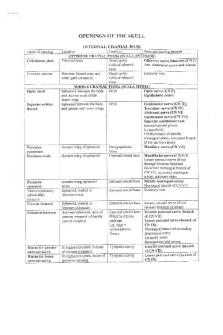Legal - Notes Regarding The Thin Skull Rule (With Examples) PDF

| Title | Legal - Notes Regarding The Thin Skull Rule (With Examples) |
|---|---|
| Author | Sarah Omar |
| Course | Criminal Law and Justice |
| Institution | University of Sheffield |
| Pages | 2 |
| File Size | 150.2 KB |
| File Type | |
| Total Downloads | 84 |
| Total Views | 123 |
Summary
Thin Skull Rule...
Description
Thin Skull Rule
Under the thin skull rule, the defendant must take his victim as he finds him. This means if he has a particularly vulnerable victim he is fully liable for the consequences to them even if an ordinary person would not have suffered such severe consequences. For example if D commits a minor assault on V who has a heart condition and V suffers a heart attack and dies. D is liable for the death of V even though such an attack would result in no physical harm to some one without a heart condition. Part of legal causation: Under legal causation the result must be caused by a culpable act, there is no requirement that the act of the defendant was the only cause, there must be no break in chain of causation, and the defendant must take his victim as he finds him (thin skull rule) This rule applies irrespective of whether the defendant was aware of the condition. 1. R v Hayward (1908) 21 Cox 692 The defendant chased his wife out of the house shouting threats at her. She collapsed and died. He did not physically touch her. She was suffering from a rare thyroid condition which could lead to death where physical exertion was accompanied by fright and panic. Both the defendant and his wife were unaware she had this condition. Held: The defendant was liable for constructive manslaughter as his unlawful act (assault) caused death. The egg shell (thin) skull rule applied. He was therefore fully liable despite the fact an ordinary person of reasonable fortitude would not have died in such circumstances. 2. The thin skull rule also applies where the victim has refused medical treatment, which would have saved them: l and( 1841)2Mo od. & R. 351 i) RvHol The defendant was involved in a fight in which he inflicted a deep cut on the victim's finger. The victim failed to take care of the wound or get medical assistance and the wound became infected. Eventually gangrene set in and the victim was advised to have his arm amputated. The victim refused and died. The defendant was liable for his death despite the victim's actions in contributing to his own death. (cut an operative cause of death) ii) R v Blaue [1975] 1 WLR 1411 Court of Appeal The defendant stabbed an 18 year old girl four times when she refused to have sexual intercourse with him. She was a practising Jehovah's witness and refused to have a blood transfusion which would have saved her life. The defendant was convicted of manslaughter on the grounds of diminished responsibility and appealed arguing that the girl's refusal to accept the blood transfusion was a novus
actus interveniens breaking the chain of causation, alternatively that Holland was no longer good law. Held: The defendant's conviction was upheld. The wound was still an operative cause of death (following R v Smith & R v Jordan) so no novus actus interveniens and Holland was still good law.
However, a different approach is taken in respect of the ‘thin skull’ in manslaughter cases. If Ed was elderly and frail, it might be foreseeable that the reasonable person would have realised it was dangerous to push Ed, as demonstrated by R v. Watson. However, Watson states that the sober and reasonable bystander will be endowed with whatever knowledge D happened to possess. If Ed was not elderly or visibly vulnerable, Jenny cannot be held liable for manslaughter. This is apparent from R v. Dawson and Others where a conviction for manslaughter was quashed on the basis that there was no way that the defendant could have known about the victim’s heart condition. Unless Ed showed some obvious sign of infirmity, the principle in Dawson is applicable to this set of facts. R v Watson: if person not old or visibly vulnerable, cannot be liable for manslaughter R v Dawson and others: manslaughter conviction quashed on basis no way D would have known about victim’s heart condition....
Similar Free PDFs

RULE 141 Legal Fees
- 10 Pages

BUS201 Exam Notes with examples
- 11 Pages

Openings of the skull
- 5 Pages

The Art of Writing SOP with Examples
- 260 Pages

Skull and trunk notes- sheetal
- 74 Pages

Hominid Skull
- 3 Pages
Popular Institutions
- Tinajero National High School - Annex
- Politeknik Caltex Riau
- Yokohama City University
- SGT University
- University of Al-Qadisiyah
- Divine Word College of Vigan
- Techniek College Rotterdam
- Universidade de Santiago
- Universiti Teknologi MARA Cawangan Johor Kampus Pasir Gudang
- Poltekkes Kemenkes Yogyakarta
- Baguio City National High School
- Colegio san marcos
- preparatoria uno
- Centro de Bachillerato Tecnológico Industrial y de Servicios No. 107
- Dalian Maritime University
- Quang Trung Secondary School
- Colegio Tecnológico en Informática
- Corporación Regional de Educación Superior
- Grupo CEDVA
- Dar Al Uloom University
- Centro de Estudios Preuniversitarios de la Universidad Nacional de Ingeniería
- 上智大学
- Aakash International School, Nuna Majara
- San Felipe Neri Catholic School
- Kang Chiao International School - New Taipei City
- Misamis Occidental National High School
- Institución Educativa Escuela Normal Juan Ladrilleros
- Kolehiyo ng Pantukan
- Batanes State College
- Instituto Continental
- Sekolah Menengah Kejuruan Kesehatan Kaltara (Tarakan)
- Colegio de La Inmaculada Concepcion - Cebu









